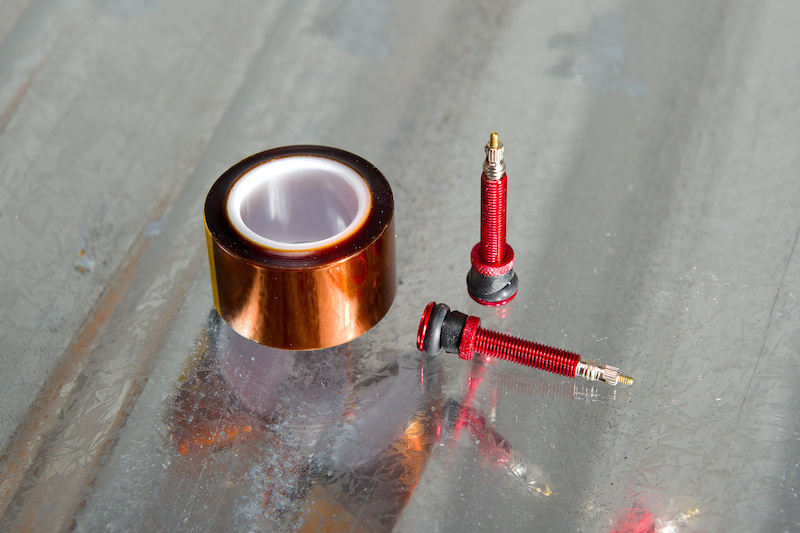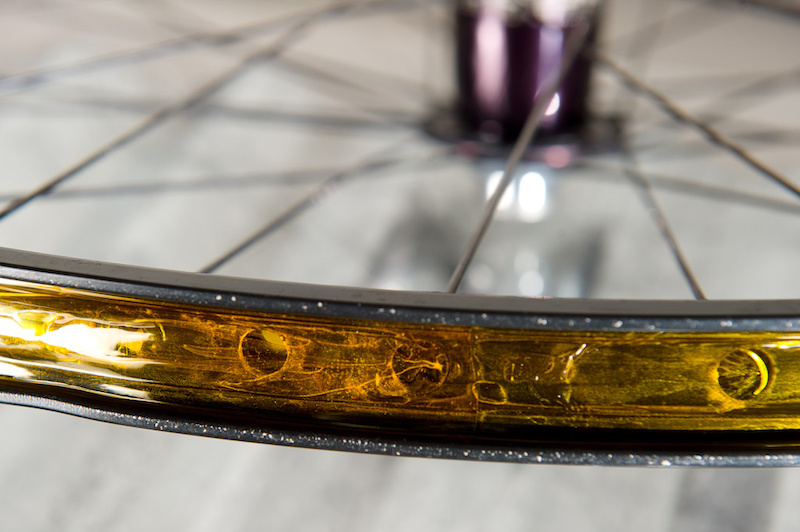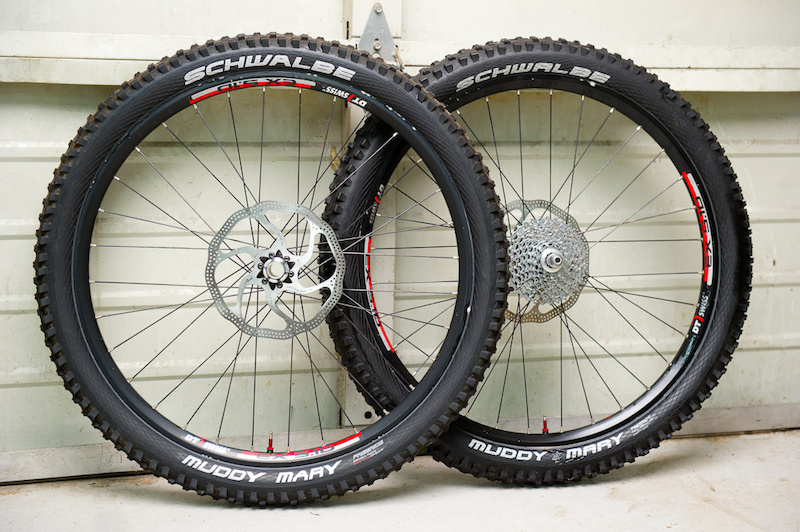Tech Tuesday - Install American Classic's Tubeless Conversion Kit
Today's Tech Tuesday is pretty simple. American Classic, a long-time player in the prebuilt custom wheel market, has developed a tubeless tire conversion that comes in a narrow, 25-millimeter XC width or a wider, 28-millimeter roll for all-mountain rims. The simple kit includes a roll of transparent tape long enough for two 29er wheels and a couple of valve stems. Tape and stems are sold separately, however, because the folks at American Classic understand that you may already own one or the other, considering that many bikes and wheelsets are equipped with tubeless conversion items these days. We discovered that the American Classic stems may be the best available, so buy a pair anyway and you'll be happy you did. As far as sealant goes; we recommend Stan's - there is no substitute. American Classic is working on a second-generation liquid sealant, but until we test it thoroughly, we're sticking with the milky white stuff from Stan the Man. American Classic price list
![American Classic Rim Tape and valve stems]()
What you' ll need to get started:
• One roll of American Classic tape
• Two American Classic tubeless valve stems (or alternative valve stems compatible with your rims)
• A soldering iron (or a large nail and a nearby flame)
• Four to five ounces of Stan's sealant (one little bottle each wheel)
• Tubeless ready or UST tubeless tires.
• A ready source of compresed air or a friend who can get vicious on a floor pump.
• Positive, winning attitude
![American Classic Rim Tape and Valve Stems]()
Tubeless Inflation Tips:
• Always inflate tubeless tires horizontal with the floor. This gives you the best chance of getting a complete seal started around the circumference of the rim.
• Don't give up right away with the hand pump. Often, only a slight amount of air is sneaking around the tire bead and a few more swift stokes will get it mounted.
• OK, so you don't have an air compressor. Buy a compressed air container and fill it with your hand pump (RC does this) or burn a large C02 cartridge and get your tire on with a three-dollar burst of carbon dioxide.
• Finally, try removing the valve core when initially inflating and mounting tubeless tires. This allows a greater volume of air to transfer instantly into the tire and often this is just enough of an advantage to inflate a troublesome tire with a hand pump.
How To Install American Classic's Tubeless Conversion Kit
![American Classic Rim Tape and Valve Stems]()
![American Classic Rim Tape and Valve Stems]()
![American Classic Rim Tape and Valve Stems]()
![photo]()
![photo]()
Something go wrong? Find detailed instructions on how to mount tubeless tires HERE.
Got some experience with American Classic's tubeless conversion components? We'd love to hear about it in the comment section.
Past Tech Tuesdays:
Visit Parktool.com to see their entire lineup of tools and lubes

American Classic sells its tubeless components separately. Tape for two wheels runs $14.00 and a pair of stems costs $12.50. Note the hefty O-rings and profiled washers to ensure that the stems seal snugly against the rim.
What you' ll need to get started:
• One roll of American Classic tape
• Two American Classic tubeless valve stems (or alternative valve stems compatible with your rims)
• A soldering iron (or a large nail and a nearby flame)
• Four to five ounces of Stan's sealant (one little bottle each wheel)
• Tubeless ready or UST tubeless tires.
• A ready source of compresed air or a friend who can get vicious on a floor pump.
• Positive, winning attitude

A soldering Iron is used to cleanly pierce the layers of plastic rim tape because melting the tape does not leave a jagged edge and thus seals better than using a blade to cut the hole.
Tubeless Inflation Tips:
• Always inflate tubeless tires horizontal with the floor. This gives you the best chance of getting a complete seal started around the circumference of the rim.
• Don't give up right away with the hand pump. Often, only a slight amount of air is sneaking around the tire bead and a few more swift stokes will get it mounted.
• OK, so you don't have an air compressor. Buy a compressed air container and fill it with your hand pump (RC does this) or burn a large C02 cartridge and get your tire on with a three-dollar burst of carbon dioxide.
• Finally, try removing the valve core when initially inflating and mounting tubeless tires. This allows a greater volume of air to transfer instantly into the tire and often this is just enough of an advantage to inflate a troublesome tire with a hand pump.

Step 1 - Begin with a clean and oil-free rim to ensure a perfect seal. Start laying the tape an inch or so before the valve hole in the rim and keep it stretched and centered between the flanges. Go around twice and then cut the tape so it overlaps an inch or so on the other side of the hole. Run a finger around the tape to seat it.

Step 2 - Locate the valve stem hole in the rim. Heat up your soldering iron and carefully melt a hole just large enough to fit the valve stem through. Heating up your mom's aluminum knitting needle over a gas stove will also do the trick.

Step 3 - Slip the valve stem through the hole with the O-ring facing the tape. Align the profiled washer with the rim and tighten snugly with just your fingers. Do not over-tighten the valve stem, this distorts the O-ring and may cause it to leak air.

Step 4 - Mount a tubeless ready or a UST tubeless tire to the rim, but leave about eight inches of the bead exposed. Pour three or four ounces of Stan's liquid sealant into the tire and then close it up by hand. Check to ensure that the beads are outside the valve stem inside the rim and then Lay the wheel on its side and inflate. At about 40 psi, you should hear the beads pop into place.

Step 5 - Once the beads pop into place, remove the air hose and spin the wheel at various angles to encourage the sealant to plug off any micro-leaks in the casing. Leave the wheels aired up to about 40 psi for a few minutes and then go ride.
Something go wrong? Find detailed instructions on how to mount tubeless tires HERE.
Got some experience with American Classic's tubeless conversion components? We'd love to hear about it in the comment section.
Past Tech Tuesdays:
Visit Parktool.com to see their entire lineup of tools and lubes
Author Info:
Must Read This Week
Sign Up for the Pinkbike Newsletter - All the Biggest, Most Interesting Stories in your Inbox
PB Newsletter Signup

RC
Does the liquid eventually gum up into a solid barrier inside? or does it always stay in its liquid form to plug any unexpected punctures?
If it gums up, is a puncture repair basically just pouring more in and sloshing it around under pressure until it plugs the hole?
I use 1" Guerilla duct tape from Home depot, $2.50. it's thicker, to prevent burping and get a tighter seal.. I wrap it two times around the wheel. (get two rolls for 2 wheels).
here's a link to my budget, slightly ghetto method.
www.facebook.com/video/video.php?v=2517657694375
I love the the Red Ano stems though, gonna get some of those!
its often only when you get a puncture that won't seal, or you want to install a brand new tire, that you notice your Stan's solution has dried out, or done the weird thing of making a "spiky starfish" (for want of a better description...) where it all coagulates into a strange spiked ball !
RC, you shouldnt entirely forget neophites.
I've got the Mary's and I'm thinking about upgrading to tubeless
what about the rims? what do they have to do?
I have to admit I have no idea on tubeless stuff
Try it anyway, you can't beat the satisfaction of hearing it pop onto the bead after you've given it loads with a trackpump!
patches take forever to dry, and what about the "terrain you ride" "requires" a fast fix? everywhere i ride i would like the fastest fix possible, i dont ever want to sit around and twiddle my thumbs.
"Leave the wheels aired up to about 40 psi for a few minutes and then go ride."
easy
Seriously though, give it a try. I've gone from semi frequent flats to 2 flats in 2 years.. I ride hard in really rocky areas. I won't go back to tubes. the only tubes I use, are when i'm giving them out to people who punctured their non-tubeless set ups.. that's when they tell me "tubeless is too much hassle".. as they are fixing their tube.. I chuckle each time. I'd rather take the time to set it up at my house, than fix tubes on the trail, while everyone waits..
you may want to bump up your sidewall a little though if you're using XC tires.. Maxxis Exo-protect is perfect for AM riding.. single wall is okay, but you have to inflate a bit more to get the rigidity out of the casing.. double case for DH, of course.
good luck and have some flat free fun! cheers
here's a link to a video showing how I set up my rims, and how to mount the tire (separate vid in the link).. a compressor is a HUGE help to mount them.. but can also be done with an air tank.. (empty metal tank, that's filled with a floor pump, so you get a fast release of air into the tire from the tank with high pressure in it..)
www.facebook.com/video/video.php?v=2517657694375
once you're converted, you'll be happy that you can reduce the air pressure in your tires some.. Pinch flats/ snake-bikes happen pretty easily with tubes, when the rim hits a rock the tube is easily pierced.. but, when you're tubeless, it takes a lot more effort to pinch through the sidewall of the tire, because of the fiber reinforcement. so, what used to result in a flat, ends up being a non issue..
with the lower pressure, you'll have better traction, because more tread is on the ground, and it will be a smoother ride, because the tire can deform over the rocks, rather than bouncing over them with higher pressure.. total win win..
good luck and have fun out there!~ PM me if you need any help. cheers, Joel
but we do in Northern Mexico, and having to patch inner tube 10 to 15 times after each single ride, would make you a blind convert to tubeless...
For AM or XC, any tire works.. some single ply tires take a little more effort to seal.. the sidewalls leak air.. you need to shake the stan's around on the inside to seal all of the holes. here's a link to a video, there's another link inside for mounting.
www.facebook.com/video/video.php?v=2517657694375
enjoy and good luck. I've had 2 flats in 2 years.
I got 15 inner tubes for £10 off ebay.
Seems like a right f*ck on.
at lower pressures, you'll get a lot of pinch flats, if you use tubes. however, with tubeless, the thin walled tube holding the air is gone.. it's now the tire.. The tire's sidewalls have fiber reinforcement so they won't split nearly as easily..
In short; Better traction, smoother ride, faster rolling and more riding because you're not stopping to fix flats. I've given out 15 tubes to riders needing a fix in the 2 years I've run tubeless.. I much prefer handing out tubes to people, than having to fix them myself. You can build a lot of goodwill with the £10 you spent by helping folks out.. as they fix their flats, you can also talk about how happy your are that you switched to tubeless.. =)
here's an easy and cheap method.. not sure if you have the same tape over there though.. best of luck, happy riding. www.facebook.com/video/video.php?v=2517657694375